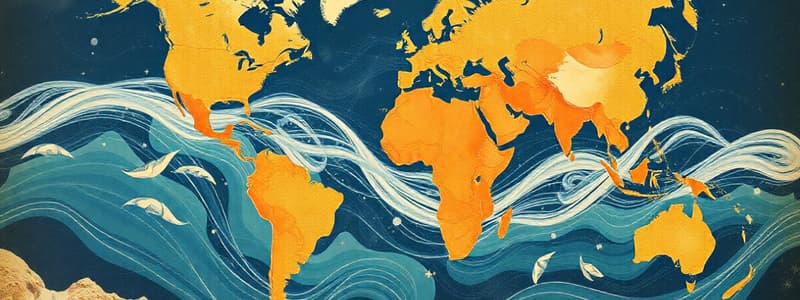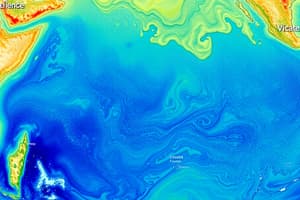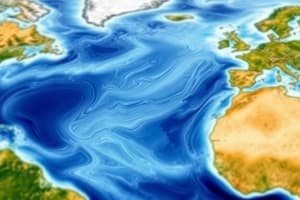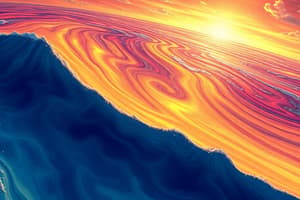Podcast
Questions and Answers
Which of the following best describes the fundamental nature of ocean currents?
Which of the following best describes the fundamental nature of ocean currents?
- Large-scale, continuous movements of water within the Earth's oceans. (correct)
- Localized areas of upwelling and downwelling in coastal regions.
- Small, temporary shifts in water temperature and salinity.
- Daily fluctuations in tidal patterns near continental shelves.
Which of these factors is considered the MOST influential in directly initiating and maintaining surface ocean currents?
Which of these factors is considered the MOST influential in directly initiating and maintaining surface ocean currents?
- Variations in water salinity across different ocean basins.
- Persistent wind patterns blowing across the ocean surface. (correct)
- Differences in water density due to temperature gradients in the deep ocean.
- The gravitational pull of the moon and sun.
To what approximate depth from the ocean surface do surface currents predominantly extend?
To what approximate depth from the ocean surface do surface currents predominantly extend?
- Up to 1000 meters below the surface.
- Extending to the ocean floor in most regions.
- Only within the top 10 meters of the ocean surface.
- From the surface down to around 400 meters. (correct)
What is a significant consequence of ocean currents regarding global environmental conditions?
What is a significant consequence of ocean currents regarding global environmental conditions?
Besides wind, which of the following is another factor that directly influences the direction and behavior of surface ocean currents?
Besides wind, which of the following is another factor that directly influences the direction and behavior of surface ocean currents?
How does gravity influence ocean currents according to differences in density?
How does gravity influence ocean currents according to differences in density?
What primarily determines the direction of ocean gyres?
What primarily determines the direction of ocean gyres?
What is the role of the continents in the formation of ocean gyres?
What is the role of the continents in the formation of ocean gyres?
What causes the differences in density that drive deep water currents?
What causes the differences in density that drive deep water currents?
What is the main effect of the thermohaline circulation on the ocean?
What is the main effect of the thermohaline circulation on the ocean?
Flashcards
What are ocean currents?
What are ocean currents?
The movement of a fluid, like water or air. In the context of oceans, it refers to the large-scale flow of water across the globe.
What factors cause ocean currents?
What factors cause ocean currents?
They are driven by wind, gravity, Earth's rotation, temperature, and salinity. These factors interact to determine the direction and speed of ocean currents.
What are surface currents?
What are surface currents?
These occur close to the ocean's surface, typically within 400 meters, and are primarily driven by wind.
How does the Coriolis effect influence surface currents?
How does the Coriolis effect influence surface currents?
Signup and view all the flashcards
How does wind drive surface currents?
How does wind drive surface currents?
Signup and view all the flashcards
What is the Coriolis effect?
What is the Coriolis effect?
Signup and view all the flashcards
What are ocean gyres?
What are ocean gyres?
Signup and view all the flashcards
How do continents affect ocean currents?
How do continents affect ocean currents?
Signup and view all the flashcards
What are deepwater currents?
What are deepwater currents?
Signup and view all the flashcards
What is thermohaline circulation?
What is thermohaline circulation?
Signup and view all the flashcards
Study Notes
Ocean Currents
- Ocean currents are the movement of water in the ocean.
- They are large-scale movements that affect the planet.
- Driven by factors including Earth's rotation, wind, gravity, temperature, and salinity.
- Affect climate, temperature, and wind patterns.
- Carry heat.
Types of Ocean Currents
- Surface currents: Occur in the upper layer of the ocean (0-400m).
- Deep water currents: Occur in the deeper ocean.
- Driven by different factors.
Surface Currents
- Primarily driven by wind, gravity, and the Coriolis Effect.
- Wind: The main driver. Friction between wind and water pushes water, creating currents.
- Wind direction is a major factor.
- Gravity: Affects water movement and density-based differences.
- Denser water (colder, higher salt) sinks.
- Less dense water rises.
- Coriolis Effect: Earth's rotation causes currents to curve.
- Gyres are circular current patterns caused by continents, wind, and the Coriolis Effect.
- Northern hemisphere gyres rotate clockwise.
- Southern hemisphere gyres rotate counterclockwise.
- Continental deflection: Landmasses cause currents to change direction.
Deep Water Currents
- Driven by differences in water density.
- Density: Temperature and salinity differences cause water density variations.
- Colder, saltier water is denser, sinking.
- Warmer, less salty water rises.
- Thermohaline circulation: Movement driven by temperature (thermo) and salinity (haline) differences.
- Also known as the Global Conveyor Belt.
- Transports heat and nutrients.
- Surface water cools, becomes denser, and sinks.
Studying That Suits You
Use AI to generate personalized quizzes and flashcards to suit your learning preferences.




